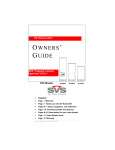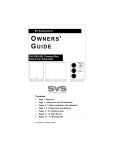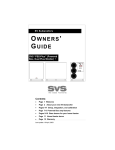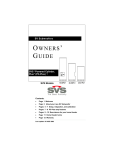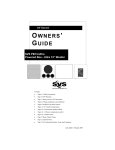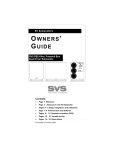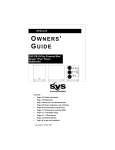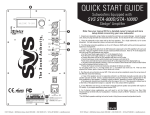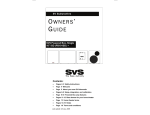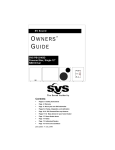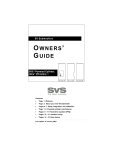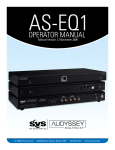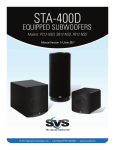Download PCi Manual all black NOV 06v2.pub
Transcript
SV Sound OWNERS’ GUIDE SVS “Powered Cylinder, Improved” (PCi) ™ SVS Models: 16-46PCi 20-39PCi • Contents: • Pages 2-3 Safety Info • Page 4 Welcome • Page 5 About your new SVS Subwoofer • Pages 6-9 Setup, integration, and calibration • Page 9-10 Powered Cylinder amp features • Pages 11-12 Bass demos for your home theater • Page 13 Home theater terms • Page 12 Warranty Last update: 25 August 2005 25-31PCi SV Sound Page 2 IMPORTANT SAFETY INSTRUCTIONS 1. Read these instructions. 2. Keep these instructions. 3. Heed all warnings. 4. Follow all instructions. 5. Do not use this apparatus near water. 6. Clean only with dry cloth. 7. Do not block any ventilation openings. Install in accordance with the manufacturer's instructions. 8. Do not install near any heat sources such as radiators, heat registers, stoves, or other apparatus (including amplifiers) that produce heat. 9. Do not defeat the safety purpose of any polarized or grounding-type plug. A polarized plug has two blades with one wider than the other. A grounding type plug has two prongs and a third grounding point. The wide blade or the third prong are provided for your safety. If the provided plug does not fit into your outlet, consult an electrician for replacement of the obsolete outlet. 10. Protect the power cord from being walked on or pinched particularly at plugs, convenience receptacles, and the point where they exit from the apparatus. 11. Only use attachments/accessories specified by the manufacturer. 12. Use only with the cart, stand, tripod, bracket, or table specified by the manufacturer, or sold with the apparatus. When a cart is used use caution when moving the cart/apparatus combination to avoid injury from tip-over. Page 3 SV Sound 13. Unplug this apparatus during lightning storms or when unused for long periods of time. 14. Refer all servicing to qualified service personnel. Servicing is required when the apparatus has been damaged in any way, such as powersupply cord or plug is damaged, liquid has been spilled or objects have fallen into the apparatus, the apparatus has been exposed to rain or moisture, does not operate normally, or has been dropped. 15. WARNING: To reduce the risk of fire or electric shock, this apparatus should not be exposed to rain or moisture and objects filled with liquids, such as vases, should not be placed on this apparatus. 16. To completely disconnect this equipment from the mains, disconnect the power supply cord plug from the receptacle. 17. The mains plug of the power supply cord shall remain readily operable. The lightning flash with arrowhead symbol within an equilateral triangle, is intended to alert the user to the presence of un-insulated "dangerous voltage " within the product's enclosure that may be of sufficient magnitude to constitute a risk of electric shock to persons. The exclamation point within an equilateral triangle is intended to alert the user to the presence of important operating and maintenance (servicing) instructions in the literature accompanying the product. Page 4 SV Sound Welcome. From the entire SVS team, congratulations on your purchase of the new standard in home theater and music bass! Your new subwoofer isn’t some generic, mass-produced box built someplace you can’t even find on a map. It’s built in our Ohio factory, by home audio enthusiasts... like you. assembled by hand, while using state of the art automation and materials in design and testing, your SVS sub is without a doubt one of the best investments you’ll ever make in bringing music and theater home. What’s more, service is as important as the products themselves at SVS. We or one of our exclusive dealers will help you set your sub up correctly, and in no time, you’ll be giving “demos” of your favorite DVDs or music disks to all your friends and neighbors (we pity them if you live in an apartment… please, be kind!). This isn’t just a “subwoofer” after all, it’s a carefully designed audio component carefully tuned in our labs, by the authorities at SV Sound. You’re unlikely to have heard, or felt, bass like this before, unless it was in a top-notch movie theater or high-end (high cost) audio boutique. Movies and music in your home will never be quite the same again. That’s a promise. Already have a question about your sub? You might answer it by reading this manual, we think you’ll find it simple and more informative than most. For even more detailed discussion about set-up topics check out our FAQs page at www.svsound.com. We touch on all the key points you need to know, and then some. Maybe you just want to share a bit of bass news? Or perhaps you have a story about your SVS Subwoofer to share with us? Maybe something we missed in our website? No matter, feel free to send a note straight to [email protected] . It’s not often you can talk to the guys who made your audio components. In this case, we look forward to it. Ron Stimpson Co-Founder SVS SV Sound Page 5 About your SVS subwoofer No powered subwoofers look anything like them, and virtually none work like them either. SVS subwoofers are decidedly different. The best part? You could have spent much more and still not come close to the same bass performance our Powered Cylinder line gives you. But what makes a subwoofer an SVS? Quality components, sane prices. You might be surprised at how inexpensive the components in some not-so-inexpensive subwoofers are. Make no mistake, we scour the earth for the best, most cost effective parts (when we don’t make them ourselves), and meld them into finely tuned designs that define high performance home theater and music bass. Want woofers, amps, or even binding posts? We’ve tested and discarded plenty that didn’t meet our tough standards. If we use it, whatever “it” is, you know it made the grade. Get “tubular”. Typical subs require heavy internal bracing and thick enclosure walls because they’re boxes. But cylinders can’t flex the way boxes do. Ever wonder why high pressure tanks are always round? At SVS form follows function, and fortunately, functional designs can lead to simple, stylish and elegant designs too. Take one look at all our subs and you’ll know this is true. Stable downward firing woofer. Our slender design is one plus, but we’ve also taken great lengths to design a downward firing driver. Coupled with our unique base-plates, which minimize driver reactive forces, you’ll find our subs can take a tremendous amount of power and remain rock solid. Compliant foam rubber feet on our innovative base plates allow for stable placement on a variety of surfaces. No rattling, or buzzing allowed! Custom low turbulence port designs. When you listen to our trend setting ported subs you’ll hear (and feel) bass like never before, with a exceptionally low noise and distortion. When you experience genuine SVS bass you’ll know something special went into it. Stylish, and understated. From the simple top grill, to the elegant base-plate, you’ll be amazed at how easy it is to lose your sub in a corner. These subs are big, but this is one of those times size does matter. There are hundreds of brands of “black box” subs out there. Fortunately, you didn’t just unpack one. World class power. Our amps are designed and built with a level of fit and finish, plus a collection of features and power, practically unheard of at this price. Did we mention power? It’s there in spades (though we rate our amps conservatively). And SVS starts with efficient designs which don’t require significant amounts of equalization to go low and flat. This way our amps can be dedicated to reproducing bass, not making up for a lack of enclosure space (the bane of clean, deep audio). As a result, we don’t require the megawatts some subs need. Plus they run cool and stabile in those vented cylinders. We sweat the details on integrating a top of the line amp in your sub, so you don’t have to. SV Sound Page 6 Setup, calibrating and integration What’s to know? Well, first of all, setting up an SVS subwoofer is pretty darn easy. There are a few key things to get right though, if you want to get the most out of your sub… Unpacking. You’re probably eager to fire up your sub (we’re the same way), but take time to carefully unpack your sub. Set the box and other protective shipping coverings aside, just in case you need to return the sub for any reason. Location. They say it’s ALL about location right? It’s the same with setting up your subwoofer. So, where to put it? Go for a corner if you can, and avoid putting your sub where it might adjoin large open areas. Studies have shown that the deepest and flattest bass response is typically attained when a subwoofer is placed within a few feet of one of your home theater’s corners, one near your main seats is usually best. The upright configuration of your SVS makes this easy. Whether you put the sub in front or to the rear of your seating area makes surprisingly little difference. Deep home theater bass, like that from Dolby Digital (DD) “5.1 channel” DVDs or high-resolution stereo or multi-channel music is non-directional. You can’t tell where it is coming from, even though you can hear and feel it. Hook-up (see fig. 1). There are a variety of ways to configure your new sub. Usually, a simple mono, shielded 75 Ohm A/V RCA type cable (a.) is used to take the subwoofer output of your DD/DTS surround sound receiver (b.) and feed the low-level input of the sub’s amp. There is no need to “split” the signal going to the PCi. You can feed either one of the two amp inputs, it doesn’t matter, right or left. (a.) NOTE: Stop now if you aren’t TOTALLY familiar with your receiver/processor manual. Ensure all power to your equipment is off when making these connections. Also, be certain your power outlet can handle a minimum of 400 watts. (Use of “convenience outlets” on receivers are not recommended for powering your sub). (b.) Fig. 1 DD/DTS Processor/Receiver (Subwoofer “Out”) SV Sound Page 7 More Setup, calibrating and integration If you are running a pair of SVS Subwoofers (fig. 2), you will need to use a standard “Y” cable adapter (c.) The best adaptor to use for this task has one male RCA connection and two female RCA outputs. (Radio Shack ® stocks them.) From the “Y” cable you can run a standard 75 Ohm signal cable (d.) to each sub thus “splitting” the Low Frequency Effects (LFE) and other bass signals from your receiver, thus feeding both subwoofers. NOTE: Now is a good time to select if you want “ON” (always on) or “AUTO ON” which turns your sub on only when a bass signal is present. (d.) “Y” cable/splitter from receiver (c.) Fig. 2 DD/DTS Processor/Receiver (Subwoofer “Out”) “Calibration” isn’t only for tech minded folks, it’s critical to a proper configuration of your home theater sound system. Fortunately, adjusting channel balance (or calibration) is as easy to do as it is important. The first order of business is making sure your DD/DTS surround sound system is set up properly. We recommend you consult your audio/video receiver (or processor) manual to refresh on the procedures to do this. Generally, this requires ensuring the receiver’s test tones, or a special test disk (like the Avia DVD) plays back at the same volume from each of your system’s full range speakers. That’s left, center, right, left surround and right surround speakers, plus the subwoofer . (More on sub level in a second). Skip now to page 7 (“Powered Cylinder Amp”) if you aren’t familiar with your sub’s amp, and come back to calibration. Some things to check as you get ready to calibrate your system: • Are your speakers set correct to the correct “size”? Your receiver/ processor might allow you to indicate if your speakers are “Small” or “Large”. Selecting the size accordingly will ensure bass goes to most appropriate speakers, and use the subwoofer correctly too. Also, is your subwoofer turned “ON”? We don’t mean “is your subwoofer amplifier on?” (that’ll be important later too!) but rather, is your receiver sending a bass signal to your sub amp? This can only happen if you say “Yes” (or “ON”) to the “Subwoofer” setting of any typical Dolby Digital/ DTS capable receiver’s set-up menu. Page 8 SV Sound • Is your receiver connected to the sub amp? Use a well-shielded RCA cable (sometimes called a “patch cord”) to hook to the subwoofer output of your DD/DTS receiver to either input jack of your subwoofer amplifier. As mentioned earlier, you’ll need to “split” the subwoofer signal with a “Y Cable” if you bought a pair of subs. • Is your Radio Shack ® sound pressure level (SPL) meter ready? This tool is absolutely essential to proper home theater audio setup. It’s akin to a tire pressure gauge for your car (you don’t set your tires by “feel” right?). Set the meter to “Slow” and “C-weighting” (and turn the dial to 70 or 80dB depending on your test tone source). Haven’t got the meter yet? Order one from SVS. We prefer the analog instead of the digital display model. Getting ready to start now: Just a few more checks. Make sure your receiver/processor master volume is set at “00 dB” or some other easy to remember reference level. Finally, ensure your SVS’s gain/volume knob is set to roughly 1/3 up, to start. It’s also critical to check the subwoofer level control of your surround receiver before you begin the test tones. Set it to no higher than -6db initially (that’s one quarter way up, given a typical receiver’s channel limits of –12 dB to +12 dB) . Your LFE “trim”, if you have one, should be set to 0dB to start (that’s full up) but this can be dialed down later to tame peaks if needed. Turn off ANY sound processing modes, “Midnight Mode”, “peak limiters”, “DRC” etc.! Now play your receiver's internal test tones so you have something to measure with your SPL meter. Or better yet, buy a calibration disk, like the Avia DVD. A test disk’s tones ensure your entire signal path, from the DVD player to your speakers, is set correctly. Whatever you use, when the tones start alternating from speaker to speaker (watch your sound meter now), set each full range speaker’s volume to about 75 dB (or 85dB if using Avia), by using the receiver’s dedicated channel level controls (leaving master volume the same). We recommend you turn down the receiver’s subwoofer output level, before you significantly lower your sub’s volume control. This helps keep input distortion to a minimum, however you should not be set much lower than –6 dB recommended earlier, since some adjustment room is needed to turn things down later (which most receivers allow via your remote control). If your subwoofer reading is still too high then turn down the sub’s amp gain/volume a little with each run. But what’s “too high”?? Tastes vary, and so do movie soundtracks, but your SVS is capable of tremendous levels of low distortion, low frequency bass — far more than most commercial subwoofers. Take advantage of this, especially if you like action movies with lots of “.1” channel (LFE) action and give the sub a bit more gain during calibration. Keep in mind too that the human ear is relatively insensitive to low frequencies. This, coupled with the fact most folks don’t watch movies at Dolby Digital reference level (loud), means turning up the bass a few dBs usually yields a better movie sound experience. SV Sound Page 9 What sub levels do we recommend? If you watch movies at relatively moderate sound levels, a range of +1dB to +3dB over your other channels is a good start. This means that the test tone will waiver about 78 dB for the subwoofer portion of the calibration run (88dB with Avia). (Note: You may rotate the sound meter SPL meter dial to the 80dB to get a good reading with these higher levels.) Note too that many modern surround sound receivers allow a variety of different subwoofer level settings, depending on the listening mode you are in. With “Surround” as your “mode” use the above calibration routine. You may well find that CD “Stereo” music mode calls for a lower bass settings in your receiver. The above is a guide — experiment! The louder your master volume though, the more you should back off the sub level to compensate. Avoid your driver bottoming, resulting in a loud “clack”! Location and measurement. You should take the above measurements from your typical preferred seat for watching movies. Be advised, strong bass levels can vary tremendously simply by moving a few feet. Such is the nature of long wave-length, low bass sound. Don’t hesitate to try different locations and different levels for your subwoofer. Calibrating too high (and often, too low) is the most common subwoofer setup error! Powered Cylinder amp We scoured the world for the best performing sub amp (that’s still affordable). The result is a custom-designed, Canadian-built, rock steady amp with incredible build quality, and an unbeatable feature set. Volume/Gain. Use volume (in conjunction with your receiver’s subwoofer output level control) to come up with a bass calibration you like. Start calibration with the sub’s volume on the low side, about 1/3 of the way up (or turned to the right). Crossover Frequency. If you use your DD/DTS receiver/processor’s internal crossover to manage bass frequencies (highly recommended), the setting of this knob on the sub is irrelevant. (Note: You should use the crossover “Enable/Disable” switch discussed below to take advantage of this configuration.) Otherwise this knob is used to best blend your SVS to your other speakers. Typically used in stereo only systems today. Phase. Think of bass waves as conflicting or enhancing each other, depending on the timing of their arrival at your listening location (either together, or not). Since some of your room’s bass might come from main, center and/or surround speakers, as well as your sub, getting these bass wave forms to arrive in a complementary, enhancing fashion is the difficult job of the variable phase. Essentially, this control varies the timing of the bass waves coming from the sub. You can change phase endlessly and not hear much difference however. But don’t despair, the effect of bass cancellation will vary by volume and frequency in your room, and no one setting is likely to ever be “perfect”. One simple technique to optimize phase is to find a nice “bassy” loop (such as the menu of the “Godzilla” movie DVD) and measure the loop’s bass response at various bass SPL peaks using a sound meter As the loop runs, have a friend vary your Page 10 SV Sound phase control. Where you see the most response on a given bass passage is the phase setting providing the least bass cancellation in your room (for the frequencies of the demo loop you chose). Line In/Out. Use one of the sub’s “Line In” jacks to connect the subwoofer to the output jack of your receiver/processor. Feeding just one input is enough. If you are using a conventional amp and/or a stereo setup you can use the “Line Out” jacks to send sound (filtered of bass information) back to your system amp. A simple RCA to RCA cable is all you need. Auto On. Your Powered Cylinder allows itself to be in an “auto on” mode…or on all the time. With the former setting (the switch in the “Auto” position) your subwoofer will “sense” that a DVD or CD etc. has begun and switch on immediately (the hard power switch mentioned below must be on naturally). A few minutes after a movie, the auto on light will turn red, switching the sub back off. When running (and sensing a signal) the auto on LED will be green. Sometimes, with very low listening levels, your amp might not get enough of a signal from your surround sound processor to “trip” the auto-on circuit. Should you ever find this to be the case you should leave this switch to “On”. Alternatively, turn UP the receiver’s subwoofer level control and turn DOWN the sub’s amp gain to compensate (always check with your SPL meter to ensure calibration remains where you want it!). Crossover Enable Switch. If you allow your DD/DTS surround-sound receiver or processor to manage bass frequencies (highly recommended), this switch should be set to “Disabled”. This disables the “Crossover Frequency” knob and allows your sub to reproduce just what it’s fed from the receiver. If you are using the sub in a two channel (stereo only) configuration then “Enable” the crossover and adjust the associated knob to best blend the sub into the low frequency output of your speakers. High level inputs/outputs. Not commonly used today, but binding posts are there in case you don’t have low-level inputs/outputs on your receiver/ processor. Typically used if you are not using a DD/DTS compatible system. Power. This heavy duty two-position switch next to the power cord will completely cut the power to your sub amp. Flip this switch to off should you ever move the sub or change inputs or outputs. A/C connection. Plug your sub into a dedicated A/C outlet. “Convenience” outlets of typical receivers often don’t provide the needed current. Avoid them. Fuse. User replaceable, contact SVS if you have trouble finding one. The fuse can be accessed by a small door immediately next to the power cord fitting (where you should also find a spare one for your use). SV Sound Page 11 Bassy demo scenes to die for. So now what?? You’ve got one of the best HT bass sub-systems on the planet, you’re calibrated...want to see what she’ll do? Sure you do! Since finding those scenes can be a bit trying, we’ve compiled a list of our favorites below. After all, calibration with test tones is important, but it’s the movies (and music) this sub is itching to show off. Chapter stops for DVDs are shown, with movie time in hours: minutes: seconds. What are you waiting for? Just hit PLAY! • • “The Iron Giant” Great family animation with SERIOUS bass, including strong peaks below 25 Hz. Jump to: 1. “Chase thru the forest” Scene 8 (20:00 into the movie) 2. “Robot Landing” (Train Impact) Scene 10 (25:40) 3. “Green Boom” Scene 27 (1:11:40) “Antz” Another good family movie, though not perhaps for small children. Extremely loud bass above 30 Hz. “Terror from Above”, Scene 17 (51:48) • • • “The Matrix” Modern, violent, science fiction classic with plenty of shoot-’em-up bass blasts. Here’s some subtle and not so subtle. 1. “Where we are grown”, Scene 12 (42:55) 2. “Landing in fight”, Scene 15 (50:51) 3. “Chopper shootout”, Scene 31 (1:47:15) “Das Boot” Arguably one of the best war pictures of all time with bass approaching 20 Hz. Very loud, very intense. 1. “Depth charges”, Scene 21 (59:30) 2. “Storm surfing”, Scene 25 (1:15:15) 3. “Hitting bottom”, Scene 17 (53:15, Side “B”) “Apollo 13” Moving story, with some surprisingly subtle, but revealing, bass where it counts. 1. “Lift off”, Scene 13 (35:15) 2. “Coming home”, Scene 53 (2:05:43) SV Sound Page 12 More Bassy demo scenes. • • • • • • “Titanic” You love it...or you hate it. Regardless of which side of the ship you sit, this flick does some serious rumbling for you: 1. “We can’t leave him” Scene 22 (2:21:50) 2. “Ship Splitting” (2:41:30) 3. “Last Gasp” (2:42:05) “Blade” Not one for the kiddies, but loaded with deep bass. 1. “Footstep”, Scene 4 (7:15) 2. “Door blown” Scene 20 (50:05) “Aliens” Not just another modern sci-fi horror classic, this one rocks from intro to final scene. 1. “Ship drop”, Scene 9 (41:20) 2. “Awakenings”, Scene 15 (1:12:52) "Apocalypse Now" Making This Vietnam war movie, Francis Ford Copolla nearly went crazy...imagine what it'll do to your subwoofer! 1. "Chopper ride" Scene 2 (0:19:47) 2. "ARC LIGHT" Scene 4 (0:26:02) 3. "Grenade launch" Scene 12 (1:27:58) “Contact” SETI with a (bass) twist or two along the way. 1. “Bombing”, Scene 28 (1:36:30) 2. “Space truckin”, Scene 33 (1:55:56) “Dark City” One of Roger Ebert’s favorites, think he likes bass too? 1. “Let the tuning commence”, Scene 8 (34:30) 2. “City makeover”, Scene 15 (1:27:45) SV Sound Page 13 A Glossary of Home Theater Terms Don’t feel guilty if you want to skip over the below. But if you are curious about what some of the terms and abbreviations stand for, read on: CD - Compact Disc, the music standard and capable of great sound. Now joined by Super Audio CD (SACD) and DVD-Audio as highresolution music alternatives that can really make subwoofers great audio upgrades. dB - Short for “deci-Bell” a unit of sound, a 3dB increase takes twice the acoustic power to attain! DD - “Dolby Digital”, the most popular form of digital surround sound, usually found on DVD soundtracks. Actually a compression algorithm that can provide 1 to 7 channels of movie audio . DPL - “Dolby Pro Logic”. The last generation of non-discreet channel surround sound. Derived from 2 “matrixed” analog channels. DTS - “Digital Theater System” similar to DD, but often with less compression. Many feel it sounds better than DD, but you be the judge. DVD - Amazing little video disk, DVD, doesn’t “mean” anything! HT - “Home Theater”. What you make of it. But a home (theater) without a subwoofer, isn’t quite up to our definition! Hz - Short for Hertz, the German scientist who came up with a scheme of measuring the frequency of sound waves. 15-30 Hz is very low bass and very rare in anything but movie soundtracks. 60-80 Hz is generally considered mid-bass above which most large full range speakers can easily produce. The real fun (and most common) deep bass, is in the middle of that range, call it 20-40 Hz. LFE - “Low Frequency Effects” are the “.1” channel in 5.1 or 6.1 channel soundtracks. If you have a sub selected in your system, any LFE signal goes to the subwoofer. The sub may get bass from other channels as well however, depending on the “size” of speakers in your set-up. RMS - A common and accurate way to rate the power of an amplifier. Literally “Root Means Squared”. Typically measured in “watts”. SPL - “Sound Pressure Level”, a fancy way of saying “Volume”. Usually measured in dBs. SPL meters are critical to setting your surround sound. Doing so by ear is nearly impossible. Sub - Short for subwoofer Page 14 Notes: SV Sound Page 15 SV Sound Authorized International Dealers: Canada Sonic Boom Audio 410 Denison street Markham, Ontario Phone: (905)944-8484 Email: [email protected] South America Liquid Sound Ltda Rua Dario Pompeu de Camargo, 467 13089-080 Campinas, Brasil Fone: +55 (0)19-9276-8820 Fax: +55 (0)19-3251-4482 Email: [email protected] Note: Not all models are available for export to SVS dealers. Check availability. Warranty: 45-day money back warranty. If you are not completely satisfied with the performance of your subwoofer, return it to us for a full refund of the purchase price. Just a few minor stipulations should you choose to do this: • The subwoofer must be returned in original shipping box. • E-mail SVS first for a return of merchandise number (RMA) and display this on the outside of the box. • The sub must be insured during shipping (SVS may arrange UPS pickup to ease any shipping damage issues). • Shipping costs are not refundable. 3 year warranty against defects in materials and workmanship. SVS will repair or replace any item at its discretion and return to the customer as soon as possible. Naturally, this warranty does not cover any product subjected to misuse, abuse, or accidental damage discovered by SVS. Except as provided above, SV Sound makes no other warranties express or implied. Some states do not permit limitation or exclusion of implied warranties, so exclusions may not apply to the purchaser. The bottom line: We’re proud of these subwoofers and want you to be as happy owning one, as we are selling one (or more) to you. E-mail us if you have any warranty question. SV Sound SV Sound 6420 Belmont Ave. Girard, Ohio 44420 Fax: 719-466-2022 Phone: 703-845-1472 Email: [email protected]
















